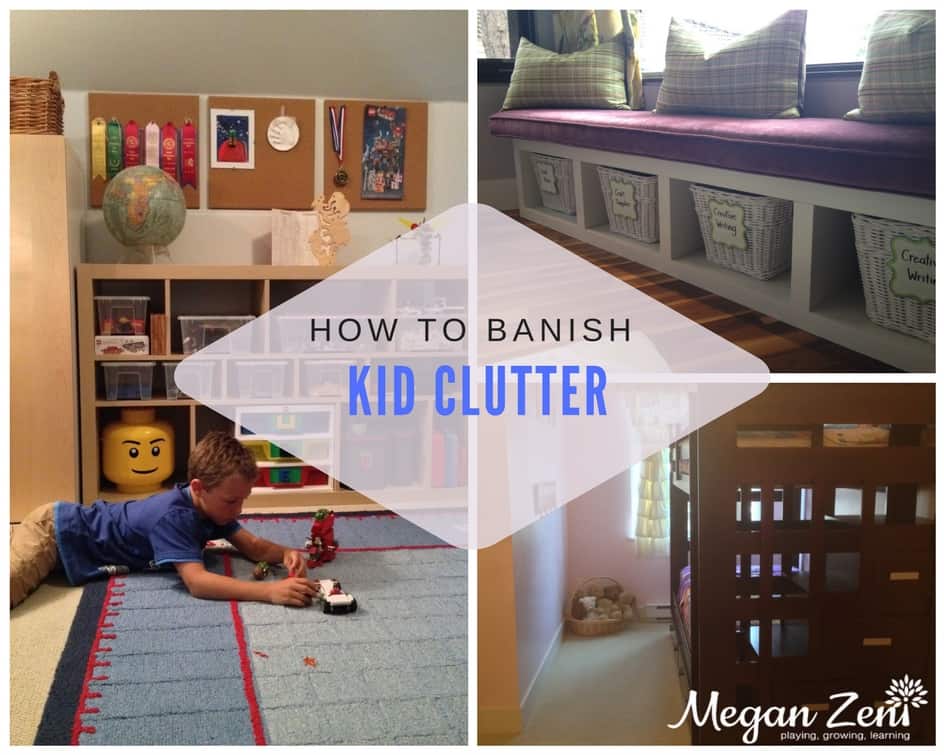- filed under: Family Life, Organizing Tips & Tricks
Kid Clutter is Visual Noise
Have you ever had to do something that required your undivided attention while the music was blaring, the TV was on, or a room full of people were laughing and shouting all around you? Then you know how it feels to be overwhelmed by noise. And kid clutter is visual noise.
But how do you manage visual noise?
Visual noise divides our attention and reduces the ability to self-regulate. Research tells us that the better a child can self-regulate, the better prepared they are for learning more complex skills and concepts at school. Many studies are showing that one of the strongest predictors of future student success, more so than IQ or academic test scores, is an early ability to self regulate. Self-regulation is a term teachers use to describe kids who either struggle with or successfully manage their ability to stay calm, alert and focused. If you are new to the term, in a nutshell, self-regulation defines a child’s ability to control the energy required to react to, and recover from, everyday stresses like waiting their turn, starting that homework, or avoiding distractions like electronics.
Similar to auditory noise, many children are very sensitive to visual noise. The chaos of an unorganized play space adds to the visual noise of childhood and detracts from the development of self-regulation. If your children are telling you that they are bored, that there is nothing to play with or if you notice that they are struggling to focus and stay calm, you may need to evaluate how much visual noise they are processing in your home.
Here’s how I tackle visual noise in our home. Affiliate links are provided for your convenience.

Assess The Imbalance Of Storage To Supplies
Develop the “place for everything and everything in its place” mindset. Start with a proper purge of all the toy bins, boxes and bags that are tucked away in your home. Empty everything out and sort like with like. This unit can help you keep everything in its place!
Make Four Piles: Keep, Donate, Sell and Garbage
Have an honest look at the piles you’ve made. If you have no idea what toy a part belongs to then it should go. I guarantee if your children are around for this Every. Single. Piece. will be their favourite long lost toy. Consider doing this step on your own. Put a box in the garage, or other out of sight location, to store toys you are not sure your child can part with. If no one has awoken in the night needing that particular doll, then after 6 months she can go to your favourite charity.
Remember: Less is More
Just about any teacher will tell you that the less kids have to play with, the more they actually play. Having a few well planned play spaces stimulates creativity and imaginative thinking. If there are too many toys in the room, set up a rotation system so your kids have that “new toy” feeling every month! If your child’s play areas are stressing you out, then there is an excellent chance that your child is not enjoying the room either! Aim for calm sightlines, clear tabletops and inviting organization.
Plan For Easy Access
If your child has to snap a lid and then close the cabinet, chances are high that the room won’t be tidy. Ever. Clear plastic shoe boxes are an easy and inexpensive way to keep like with like while sorting your pieces into collections. Take a good look at the room and imagine having a few minutes to tidy it up before company arrives. Now go buy storage systems that let you do that!
Label, Label and Label
If you have pre-readers in the home, use photographs to label the contents of each bin. If your children are reading, saturate the room with what teachers call environmental print; give every bin a printed label. Children quickly learn new sight words this way!
Define The Play Space
Area rugs are an extension of the Montessori philosophy of defining the work space. In short, the idea that a child has “freedom within limits” allows children to play within the confines of the rug without toys spilling out all over the room. In my experience, this is an easy addition to any play space to maximize play and reduce frustration for both children (lost pieces) and adults (contained mess). Choose low pile and well cushioned area rugs to define the play space. By reducing the clutter (visual noise) and increasing prepared imaginative play spaces for kids, parents provide opportunities for problem solving, self-regulation and independence. Children happily create chaos, but crave natural order and routine. RELATED POST: How to organize your child’s bedroom
And if you are looking for inspiration for all those de-cluttering jobs you want to get started on, come follow me on Pinterest:
